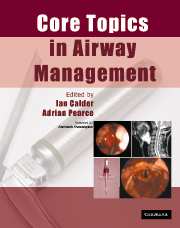Book contents
- Frontmatter
- Contents
- List of contributors
- Preface
- Acknowledgements
- List of abbreviations
- 1 Anatomy
- 2 Physiology of apnoea and hypoxia
- 3 Physics and physiology
- 4 Cleaning and disinfection of airway equipment
- 5 General principles
- 6 Maintenance of the airway during anaesthesia: supra-glottic devices
- 7 Tracheal tubes
- 8 Tracheal intubation of the adult patient
- 9 Confirmation of tracheal intubation
- 10 Extubation
- 11 Light-guided intubation: the trachlight
- 12 Fibreoptic intubation
- 13 Retrograde intubation
- 14 Endobronchial and double-lumen tubes, bronchial blockers
- 15 ‘Difficult airways’: causation and prediction
- 16 The paediatric airway
- 17 Obstructive sleep apnoea and anaesthesia
- 18 The airway in cervical trauma
- 19 The airway in cervical spine disease and surgery
- 20 The aspiration problem
- 21 The lost airway
- 22 Trauma to the airway
- 23 Airway mortality associated with anaesthesia and medico-legal aspects
- 24 ENT and maxillofacial surgery
- 25 Airway management in the ICU
- 26 The airway in obstetrics
- Index
2 - Physiology of apnoea and hypoxia
Published online by Cambridge University Press: 15 December 2009
- Frontmatter
- Contents
- List of contributors
- Preface
- Acknowledgements
- List of abbreviations
- 1 Anatomy
- 2 Physiology of apnoea and hypoxia
- 3 Physics and physiology
- 4 Cleaning and disinfection of airway equipment
- 5 General principles
- 6 Maintenance of the airway during anaesthesia: supra-glottic devices
- 7 Tracheal tubes
- 8 Tracheal intubation of the adult patient
- 9 Confirmation of tracheal intubation
- 10 Extubation
- 11 Light-guided intubation: the trachlight
- 12 Fibreoptic intubation
- 13 Retrograde intubation
- 14 Endobronchial and double-lumen tubes, bronchial blockers
- 15 ‘Difficult airways’: causation and prediction
- 16 The paediatric airway
- 17 Obstructive sleep apnoea and anaesthesia
- 18 The airway in cervical trauma
- 19 The airway in cervical spine disease and surgery
- 20 The aspiration problem
- 21 The lost airway
- 22 Trauma to the airway
- 23 Airway mortality associated with anaesthesia and medico-legal aspects
- 24 ENT and maxillofacial surgery
- 25 Airway management in the ICU
- 26 The airway in obstetrics
- Index
Summary
Ethical constraints make the study of this all important topics very difficult. Simple questions, such as how long will an apnoeic patient survive? – cannot be answered with precision.
Classification of hypoxia
‘Cellular respiration’ occurs at the level of the mitochondria, when electrons are passed from an electron donor (reduced nicotinamide adenine dinucleotide (NADH)) via the mitochondrial respiratory cytochromes to ‘reduce’ molecular oxygen (O2). The energy from this redox reaction is used to phosphorylate adenosine diphosphate (ADP), thereby generating the universal energy source, adenosine triphosphate (ATP), which powers all biological processes. If molecular O2 cannot be reduced in this way, this bit of biochemistry fails and cellular hypoxia occurs. Based on Barcroft's original classification, four separate causes of cellular hypoxia can be considered. Three of these four factors affect O2 delivery to the tissues (D. O2), which is described mathematically by the equation in Box 2.1. Derangements of each of the terms on the right-hand side of this equation will reduce O2 delivery to tissues.
The fourth cause of cellular hypoxia in our classification is histotoxic hypoxia. An example of this is cyanide or carbon monoxide poisoning. In histotoxic hypoxia, there is not (or there need not be) any deficit in O2 delivery. Cellular and mitochondrial partial pressure of O2 (PO2) may be more than adequate, but the deficit lies in the reduction of molecular O2 due to a failure of electron transfer. In order to fully understand the classification of hypoxia, it is useful to consider the example of carbon monoxide poisoning.
What is the mechanism of death in severe carbon monoxide poisoning?
After an unsuccessful suicide attempt involving motor exhaust-gas inhalation, a patient is taken to hospital.
- Type
- Chapter
- Information
- Core Topics in Airway Management , pp. 9 - 20Publisher: Cambridge University PressPrint publication year: 2005



